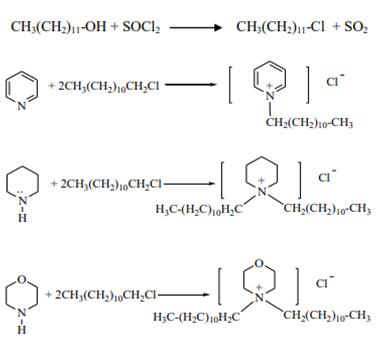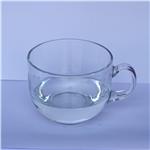What is 1-chlorododecane?
Lauroyl chloride is an important organic intermediate and is widely used in the synthesis of surfactants, and it is also used in the synthesis of rubber scorch retardant, medicine and pesticide.
How to synthesis 1-chlorododecane? 500 ml round-bottomed flask fitted with a double surface condenser and charged with 109.5 ml (or 179 grams) of freshly distilled thionyl chloride, and 46.5 grams of n-dodecyl alcohol (lauryl alcohol) are slowly added during 2 hours. When all the n-dodecyl alcohol has been added, the reaction mixture is refluxed for 6 hours. The obtained reaction mixture is distilled and the excess of thionyl chloride passes over below 80° C, followed by a small fraction up to 120° C. Finally, the crude 1-chlorododecane distills at 252-257° C, mainly at 255-257° C. The purified 1-chlorododecane is washed with water, 10% sodium carbonate solution, twice with water and dried with anhydrous calcium chloride. 1-Chlorododecane is additionally purified by distillation through an efficient fractionating column. Pure n-hexyl chloride passes over at 116.5° C/5 mm. The yield is 35 grams [1].
As the raw material for surfactants preparation, 1-chlorododecane is always used to prepare cationic surfactant.
As early as in 1997, A abdelazim M. A. Omar and Nagui Abdel-Khalek synthesized three cationic surfactants: N-dodecyl-N-monoethanol ammonium chloride, N-dodecyl-N,N-diethanol ammonium chloride and N-dodecyl-N,N,N-triethanol ammonium chloride, and they were prepared by condensing 1-chlorododecane with stoichiometric amounts of either mono-, di- or triethanol amine [2].
There is another example of 1-chlorododecane to prepare surfactant. The process of fatty Piperidinium and Morpholinium chlorides preparation. As shown in scheme 1, piperidine (1mol, 0.85 g) or morpholine (1mol, 0.87g) and chlorododecane (2mol, 4.09g) were refluxed in toluene for 24 h.. The resulting mixture was cooled to room temperature and washed repeatedly with diethyl ether to remove both chlorododecane and toluene, then evaporated under reduced pressure giving a viscous red oil. The product was recrystallized by using ethanol.

Scheme 1 Synthesis of Cationic surfactants with long alkyl chain
References
[1] https://www.prepchem.com/synthesis-of-1-chlorododecane/
[2] A abdelazim M. A. Omar and Nagui Abdel-Khalek, Cationic surfactants as flotation collectors: Surface and thermodynamic parameters of some cationic surfactants with special reference to their use as flotation collectors, May 1997 Tenside Surfactants Detergents 34(3):178-182
[3] Nihal O.Shaker et. al., PYRIDINIUM, PIPERIDINIUM AND MORPHOLINIUM CATIONIC
SURFACTANTS(1): SYNTHESIS, CHARACTERIZATION, HEMOLYSIS AND ANTIOXIDATIVE EFFICIENCY, Az. J. Pharm Sci. Vol. 48, September, 2013, 130-143
You may like
Lastest Price from 1-Chlorododecane manufacturers

US $10.00/KG2025-04-21
- CAS:
- 112-52-7
- Min. Order:
- 1KG
- Purity:
- 99%
- Supply Ability:
- 10 mt

US $0.00-0.00/KG2025-04-15
- CAS:
- 112-52-7
- Min. Order:
- 50KG
- Purity:
- 99%
- Supply Ability:
- 500000kg


